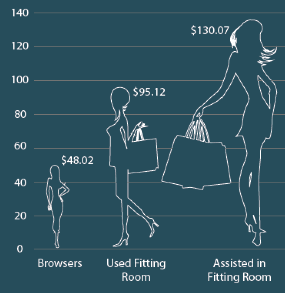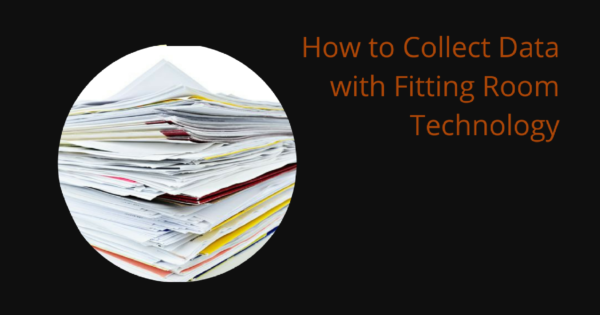At Alert Tech, we get a number of frequently asked questions about our fitting room technology. Two of the most common questions are:
- What is your system used for?
- How can it make my retail store more effective at providing a stellar customer experience?
I’ll break down the answer to the first question into the main hardware components:
- fitting room occupancy sensors give retailers insight into an area where you can’t install cameras
- call buttons allow shoppers to request sales assistance when they are already in the fitting room (Of course, there’s a lot more to it than that. You can read more about what kinds of customers use call buttons and why fitting room call buttons boost sales.)
- most retailers use iOS devices to control the fitting room situation (for instance, our app can be used to reserve fitting rooms, add customer names, and store important item information)
However, our fitting room technology provides more than just a means for better customer service. Our system also collects data that can be helpful to retailers. What types of data can our system record, and how can your store benefit from it? Read on to learn more.
What Data You Should Be Collecting about Customer Fitting Room Use
At a minimum, we recommend that retailers collect four specific pieces of information about the customers that go into their fitting rooms. These are:
- The number of total fitting room visits
- The number of fitting room calls
- The length of response time for fitting room calls
- How long customers are spending in fitting rooms
Number of Fitting Room Visits
This piece of data is an important data point for any apparel retailer since it essentially measures the effectiveness of your store as a whole. When someone makes the choice to go into a fitting room and try on a piece of clothing, the chance that they will make a purchase increases by almost 7 times. Therefore, the more people you have heading into the fitting rooms, the better your store is doing at creating an atmosphere that makes customers want to buy.
A smart fitting room call button can measure how many people went into the fitting room in the first place—data you can compare to door traffic to measure your conversion from sales floor to the fitting room.
The conversion of door traffic to fitting room traffic is one of the most important benchmarks in retail apparel. We find that many of our clients, once they start monitoring this conversion, discover that they have a widespread in conversions across stores. One client discovered that their store with the highest door traffic had the worst conversion to fitting room traffic. Talk about a massive opportunity for improvement!
Number of Fitting Room Calls
Because call buttons are not yet being used universally in retail, it’s important for your sales associates to explain and encourage the use of the technology when customers are entering into the fitting rooms.
Your customers will only press the button for assistance if they know what that button does, and possibly only if they’ve been invited to do so. This means that the number of fitting room calls can help you learn whether or not your associates are consistent in inviting customers to use the call button.
 At Alert Tech, we’ve found that customers who use the call button have a basket size almost three times that of customers who browse.
At Alert Tech, we’ve found that customers who use the call button have a basket size almost three times that of customers who browse.
Customers who initiate calls for service from the fitting room are essentially saying “Help me buy something!” to your associates. Therefore, when you know that customers are using the call button to ask for help, you know that they are also putting trust in your salespeople for assistance—which can ultimately boost the trust and loyalty they have for your store in general.
Bottom line, you want your customers to use the call button frequently when they are in the fitting rooms, and this data measure can help you assess and improve that frequency.
[Tweet “How to Collect Data with Fitting Room Technology #fittingroom @alerttechinc”]
Length of Response Time
Speaking of trust and loyalty, your customers will put more trust in your salespeople—and become more accustomed to using the call button frequently—if your associates are responding in a timely manner.
Alert Tech call buttons track the length of time it takes an associate to respond after a customer pushes a button, which you can in turn use to help answer questions such as whether or not your store is adequately staffed, or whether or not your associates are adequately trained in customer service.
[xyz-ihs snippet=”TOFU2-Retail-Analytics-Button”]
Occupancy Time
Some stores want to turn over their fitting rooms quickly, to get more customers in and out at a faster clip. This makes sense if you’re looking to minimize lines at the fitting room, but overall the practice is both counterintuitive and counterproductive, because the longer a properly serviced customer stays in the fitting room, the more they will buy. (The industry average for fitting room occupancy is usually between 5 and 8 minutes for optimum results.)
Instead of moving customers quickly through the fitting room, your associates should focus on properly managing fitting room queues, and providing prompt service and an excellent experience while the shoppers are using the fitting rooms.
Measuring how long your customers are spending in the fitting room can help you develop customer service strategies that will improve your fitting-room-to-sale conversions.
What the AlertTech Fitting Room Call Button System Can Do
AlertTech’s Sense System is a robust and sophisticated call button with built-in logic and the capability of recording all four of the data points listed above.
Based on the results of our retailers, we have no doubt that implementing our system will improve the experience your customers have in the fitting room. And since customers who decide to go into fitting rooms are so much more likely to make a purchase than the rest of the shoppers out on the floor, you can bet that your floor-to-sale conversions (and your revenues) will benefit from a call button system.
On this blog, our goal is to share retail insights and tools that make your life easier. Please check out our complimentary guide to Retail Analytics management and optimization to improve the returns on your brick and mortar investment.
Retail Analytics: How to Collect Data for Your Retail Operation, and What to Do With It
[xyz-ihs snippet=”TOFU2-Retail-Analytics”]

